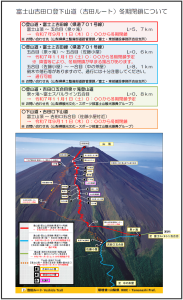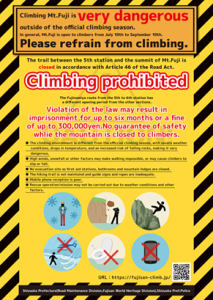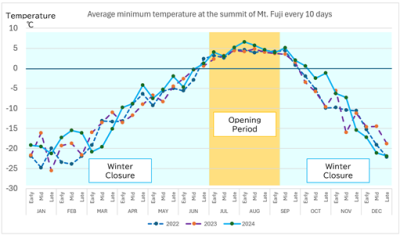Mt. Fuji outside the official climbing season
| ‐ The official climbing season for Mt. Fuji is as follows each year: - |
| Yamanashi Pref. | Yoshida Trail | from JUL. 1st to SEP. 10th |
| Shizuoka Pref. | Subashiri Trail | from JUL. 10th to SEP. 10th |
| Gotemba Trail | from JUL. 10th to SEP. 10th | |
| Fujinomiya Trail | from JUL. 10th to SEP. 10th (5 - 6th Sta.: Late June to early November) |
All trails to the summit of Mt. Fuji are closed outside the official climbing season.
(The Fujinomiya Trail from the 5th to 6th station has a different opening period from the other sections.)
Violation of the law may result in imprisonment for up to six months or a fine of up to 300,000 yen.
[ Multilingual Ver. of Shizuoka Pref. Flyer ]
Climbing Mt. Fuji outside the official season is extremely dangerous.
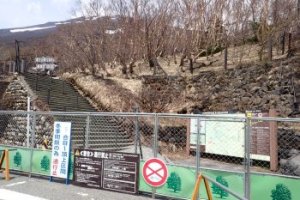
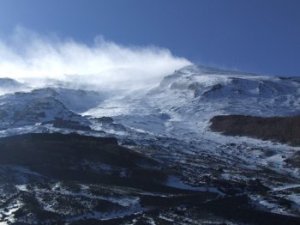
There have also been fatal accidents involving experienced climbers who were well-equipped and knowledgeable.
Conditions of Mount Fuji Outside the Climbing Season
Unlike in the summer climbing season, the mountain can become extremely dangerous, even for experienced climbers with the proper equipment, training, and physical fitness. Please read the following information carefully and understand the risks involved.
Furthermore, even more severe than the temperature on Mount Fuji outside of the open season is the strength of the wind. It is said that the average wind speed is over 15m/s, and that maximum wind speeds can exceed 40m/s. It is not uncommon for pebbles from scoria to fly and hit you in the face or eyes, or for sand and snow dust to fly and block your view. There is also the risk of falling due to gusts of wind or slipping on icy surfaces (many accidents have occurred, especially in early spring).
.jpg)
.jpg)
During the climbing season, typhoon damage and landslides are quickly fixed. But after the season ends, trails are no longer maintained. Safety signs, maps, and ropes are removed or stored, making the climb more dangerous. Without maintenance, falling rocks become a serious threat to life.
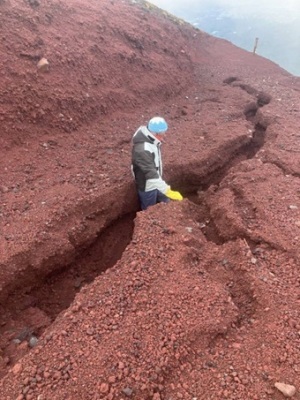
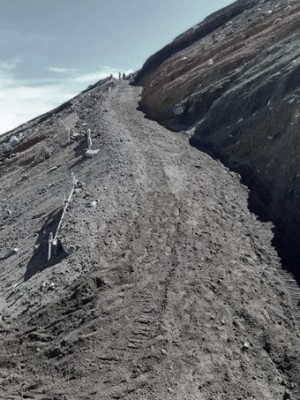
During climbing season, mobile carriers add extra base stations to support climbers. After the season ends, these facilities are shut down, and phone service is scarce.
If an accident happens, rescue can be very hard because of bad weather. It’s not just risky for the injured person—rescuers can also be put in danger.
Outside the Official Climbing Season: Issues of Disturbance and Trespassing
Some people may still think that climbing just before or after the official season is feasible, even if mid-winter climbs are impossible. However, this period is crucial for maintaining Mt. Fuji’s facilities, including repairs and renovations of mountain huts and construction of infrastructure such as diversion dams. These tasks must be completed during the limited periods outside mid-winter, while carefully considering the weather.
Guidelines for Off-season
For safety reasons, climbing Mt. Fuji outside the official climbing season is extremely dangerous and is strongly discouraged.
However, in reality, some climbers with sufficient knowledge, experience, and physical strength attempt to climb the mountain during the off-season at their own risk, which can sometimes result in accidents.
In order to prevent such accidents and to preserve the natural environment, the "Guidelines for Ensuring Safety When Climbing Mt. Fuji" (mainly precautions to take outside of the summer mountain season) were established in 2013.
There are rules in place for Mt. Fuji, including a prohibition on climbers who are not fully prepared from climbing outside of the summer mountain season, so please abide by these rules. The main points are as follows:
1. No one is allowed to ascend the mountain unless they are fully prepared.
2. A Climbing Plan must be completed and submitted.
3. Off-season climbers bring their own portable toilets.
Leaflets of the guidelines
Three off-season regulations, Map of Mt. Fuji and Useful Information for Climbing Mt. Fuji in summer.
Contact
Yamanashi Prefecture
Culture, Tourism and Sports Department Mt.Fuji Tourism Promotion Division
Phone: 055-223-1315
Shizuoka Prefecture
Sports, Culture and Tourism Department Mt. Fuji World Heritage Divison
Phone: 054-221-3746
Ministry of the Environment
Fuji-Hakone-Izu National Park National Park Office
Phone: 0460-84-8727
- For all Mt. Fuji climbers for 2025
- Highlights
- Flowchart
- 1. Risks
- 2. When to go
- Climbing season
- Avoid "Traffic Jams"
- Mt. Fuji outside the official climbing season
- 3. Mountain Trails
- 4. Itineraries
- 5. Access
- 6. Equipment
- 7. Etiquette
- 8. Weather



